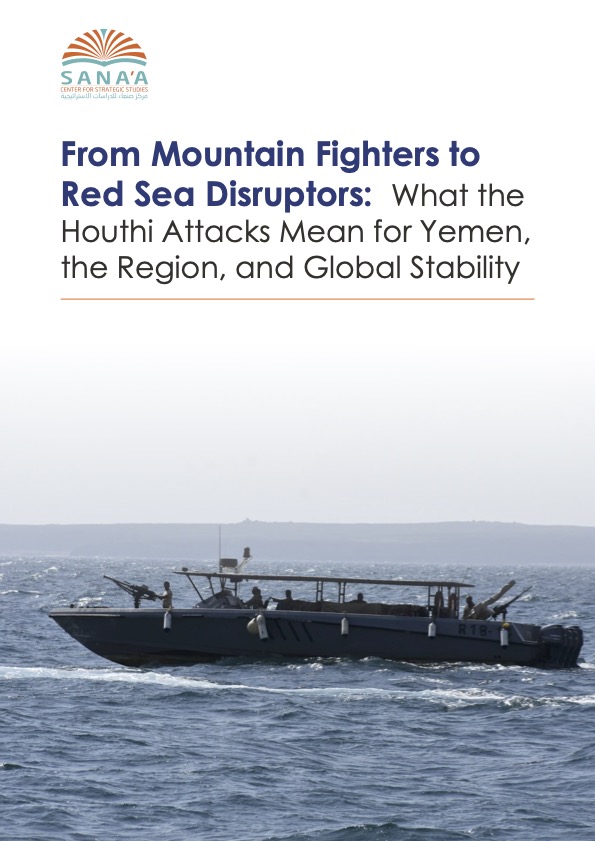Increased Houthi attacks against maritime and coastal targets have generated an escalating series of national, regional, and international problems. Indeed, the maritime warfare that the Houthis have undertaken since 2016, with attacks rising in frequency and complexity since the start of the Israel-Hamas war in October, has four interconnected implications. First, it deprives the internationally recognized government of oil revenues. Secondly, it undermines the rebuilding of the Yemeni Coast Guard. Third, it keeps neighboring Saudi Arabia on constant alert and poses a security threat to its oil infrastructure and Vision 2030 giga-projects. Fourth, it jeopardizes freedom of navigation in the southern Red Sea, which is rapidly changing the way the international community perceives the threat from Houthi-controlled territories as attacks increase in solidarity with Gaza. The group now threatens to prevent the passage of all ships heading to Israel.
The Trajectory of Houthi Military Capacity
The Houthis have gradually developed their maritime asymmetric warfare capabilities (anti-ship missiles; remote-controlled boats/water-borne improvised explosive devices; floating sea mines; hijackings), and aerial arsenal (rockets; drones; missiles) for use against maritime and littoral targets. They have achieved this despite their origins as an armed movement from the mountains. The bulk of the Houthi movement is from the northern city of Sa’ada, where its political-military leadership originates and is still based. Sa’ada lies in a mountainous valley at almost 2,000 meters above sea level, and the rugged terrain lent itself to the guerrilla warfare and attrition the group utilized in the Sa’ada Wars against the government between 2004 and 2010.
In their rapid expansion during the civil war, the Houthis seized Hudaydah, the main port city on the Red Sea, and now control the strategic islands of Kamaran, Ras Douglas, and Taqfash off the Hudaydah coast. This has provided the group with an invaluable theater for maritime projection, disruption, and area denial. Their evolution from a guerrilla movement to a more capable military actor wouldn’t have been possible without the alliance of convenience with the power bloc of former president Ali Abdullah Saleh and the absorption of soldiers and materiel from the regular army and the Republican Guard. But the role of Iran has been decisive in providing the Houthis with smuggled weapons and expertise to project power into the Red Sea and Bab al-Mandab Strait. For the Houthis, maritime attacks are now tools of military and political pressure, as they are for Iran in the Northern Arabian Sea – since 2019, several Iran-linked attacks against oil tankers and commercial vessels have occurred close to the Hormuz Strait and the Gulf of Oman. The 2020 final report of the UN Panel of Experts on Yemen noted “an increasing number of incidents involving suspicious approaches and attacks on civilian ships” by the Houthis in the Red Sea.
The Changing Geography of Maritime Attacks
In the last two to three years, the geography of Houthi maritime activity has changed. Between 2015 and 2017, the Bab al-Mandab Strait was the focus of Houthi maritime attacks, after they had seized most of Taiz governorate. But the Emirati-backed National Resistance forces, led by Tareq Saleh, retook control of the Bab al-Mandab area (including the coastal town of Al-Makha) in 2017, pushing the Houthis to withdraw northward. From then on, the main flashpoint moved to the southern Red Sea, close to the Houthi-controlled port of Hudaydah. Amid rising humanitarian concerns, the UN-brokered Stockholm Agreement, signed in 2018 between the internationally recognized government and the Houthis, halted the offensive on the port city. Alongside numerous ceasefire violations along the front, the Houthis reneged on provisions for the mutual redeployment of forces from the ports of Hudaydah, Salif, and Ras Issa, and the channeling of port revenues to pay public sector salaries. Military positions in Hudaydah crystallized until 2021, when the Joint Western Forces (a Tareq Saleh-led coalition comprising the National Resistance forces, the remnants of the Tihama Resistance, and the Giants Brigades) withdrew from the coastline in November 2021 to redeploy to other fronts, helping the Houthis regain territory. In a demonstration of their renewed hold on the strategic area and their ability to disrupt navigation in the Red Sea, the Houthis staged a military parade in Hudaydah displaying anti-ship missiles.
Ramifications of Houthi Red Sea Operations
The first implication of Houthi attacks against maritime and littoral targets regards the economic war vis-à-vis the internationally recognized government. In October-November 2022, the Houthis – who do not control Yemen’s major oil and gas fields – attacked two oil export ports in government-held areas with drones and missiles: Al-Dhabba in Hadhamawt and Qana in Shabwa. The strikes occurred while the Houthis were holding secret bilateral talks with Saudi Arabia, after failing to extract further concessions from the government in negotiations to extend a nationwide truce. The attacks did not damage infrastructure but prevented foreign tankers from entering the ports and onboarding oil, and forced the immediate suspension of nearly all oil exports. According to the government, the attacks resulted in US$1 billion of prolonged loss of revenues, with a significant drop in oil export activity.
The second implication concerns the government-aligned Yemeni Coast Guard. Since 2016, the Coast Guard has been undergoing a rebuilding process supported by Saudi Arabia and the United Arab Emirates as they pivot from preventing jihadi attacks to countering smuggling activities, mostly to and from Iran. But plans to rebuild a coherent and effective coast guard have little chance of success as long as the Houthis remain in control of the Hudaydah coast and its islands. This diminishes the stabilizing role Yemen could play – given its unique geography – in the Red Sea, the Bab al-Mandab Strait, and the Arabian Sea. Yemen has been a member of the Combined Maritime Forces (CMF), a US-led multinational naval mission, since 2013. The US Ambassador to Yemen and the Commander of Centcom (the US Naval Forces Central Command and CMF) met in March 2023 with senior Yemeni Coast Guard officials and government representatives in Al-Mahra to discuss regional maritime security efforts and prospects for multilateral naval cooperation. A small-boat operations course for Coast Guard personnel will be organized in Bahrain (CMF’s headquarters) to upgrade interoperability with regional partners. In October 2022, the Yemeni Coast Guard joined ships from Japan, the Republic of Korea, and Spain for a counter-piracy patrol in the Gulf of Aden led by Brazil under Combined Task Force 151.
The third implication is for the Houthis’ power to influence the negotiating position of Saudi Arabia concerning Yemen. In 2020, the final report of the UN Panel of Experts on Yemen stated that more sophisticated, longer-range uncrewed aerial vehicles and land attack cruise missiles had been deployed by the Houthis, mostly to attack targets in Saudi Arabia. According to the panel, “these attacks coincided with an escalation of regional and geopolitical tensions over the Joint Comprehensive Plan of Action and seemed intended to force Saudi Arabia to adopt a more conciliatory approach towards the Houthis.” As the Houthis step up attacks in the Red Sea, the Saudis are now reportedly urging the US to exercise restraint. They are worried that a more assertive American posture could cause the bilateral talks to collapse: for the kingdom, the main risk would be to have its territory and economic interests in the sights of Houthi missiles again. The parties’ commitment to a set of measures to implement a nationwide ceasefire, announced by the UN on December 23, is a significant step; however, it isn’t likely to produce a de-escalation effect in the Red Sea since the Houthis believe that they can gain more concessions at the negotiating table if they raise the threat level against regional and global interests. Securing the border and stopping attacks from Yemen were precisely the reasons that led Riyadh to support a nationwide truce in 2022 and start direct talks with the Houthis in the first place.
The fourth implication of Houthi attacks is the dilemma they generate for the United States and the international community. Maritime security is an issue of global concern, particularly in the busy sea lanes through the Red Sea, with far-reaching impacts on energy and commodities markets. However, the US faces risks regardless of how it chooses to respond. On the one hand, if the Americans show restraint, as they have done so far, the Houthi threat to shipping will remain unchecked. On the other hand, if the US opts for expanded military action, or a stronger naval presence in the Red Sea under a resolute mandate to respond, (which doesn’t seem to be the case with the recently announced Operation Prosperity Guarantor, which will operate “under the umbrella” of existing Combined Task Force 153), it must be wary of the potential fallout for the Saudi-Houthi talks and the region more broadly (e.g., the reaction of Iran and its proxies). In both cases, tight coordination with regional partners, starting with the Gulf states, will be a key step.
Eight years after the Yemen war began, the Houthis’ hold on Hudaydah and their acquisition of maritime capabilities are no longer just a problem for Yemen and its neighborhood – they have implications for the whole world.
This commentary is part of a series of publications produced by the Sana’a Center and funded by the government of the Kingdom of The Netherlands. The series explores issues within economic, political, and environmental themes, aiming to inform discussion and policymaking related to Yemen that foster sustainable peace. Views expressed within should not be construed as representing the Sana’a Center or the Dutch government.

 اقرأ المحتوى باللغة العربية
اقرأ المحتوى باللغة العربية
